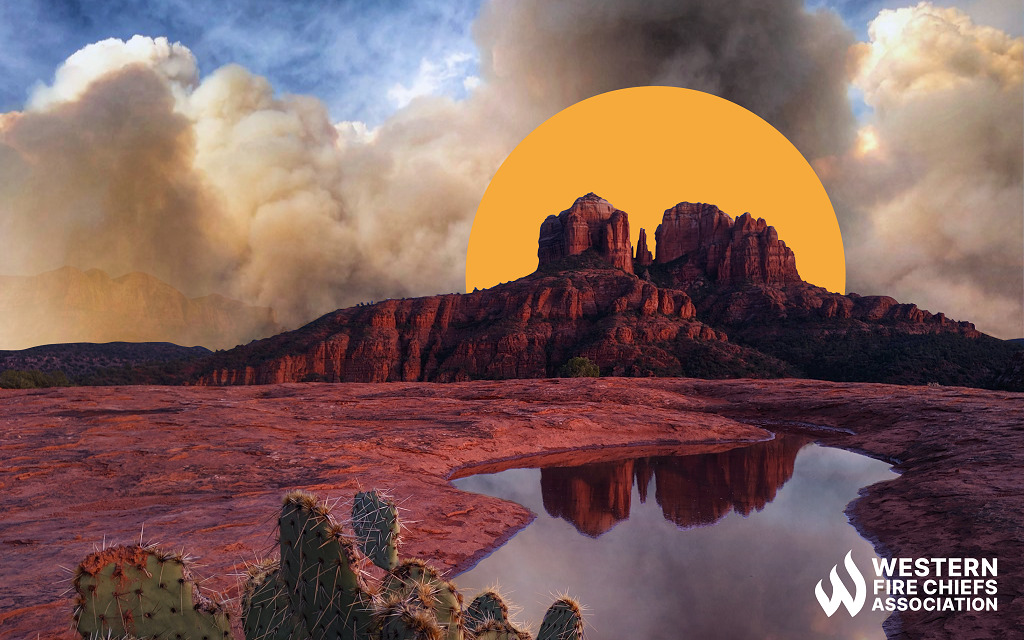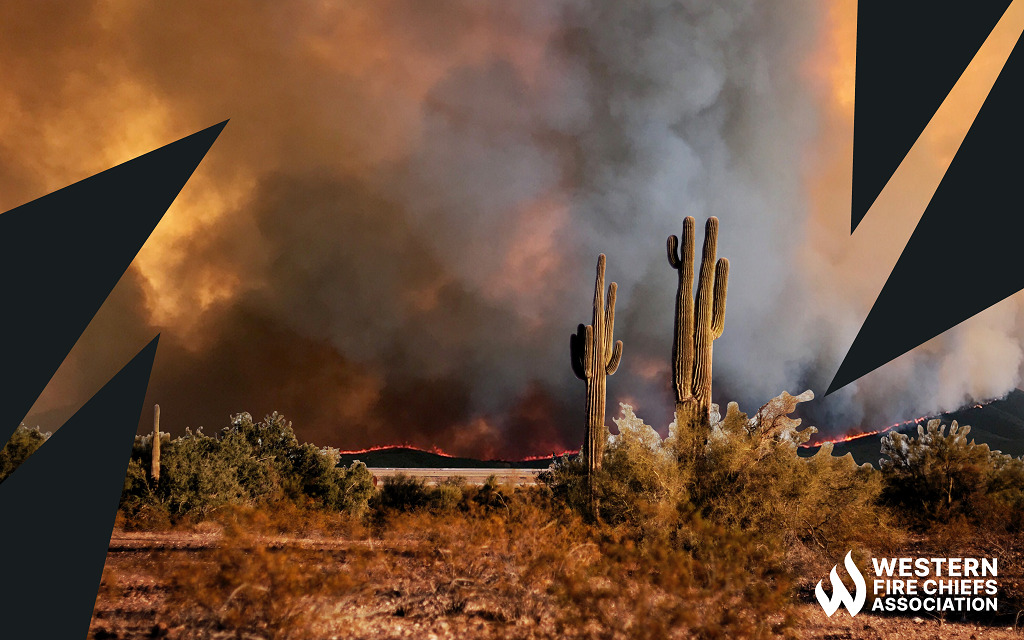Fire Pit Safety Tips
Stay safe around the campfire with tips from the Western Fire Chiefs Association. Learn essential precautions and practices for a worry-free outdoor campfire.
Explore details regarding the Arizona fire season from the Western Fire Chiefs Association (WFCA). Learn when is it, how long it lasts, risk factors and more.
Published:June 13, 2023
Edited:April 24, 2024

Explore details regarding the Arizona fire season from the Western Fire Chiefs Association (WFCA). Learn when is it, how long it lasts, risk factors and more.
Arizona has a semi-arid climate, with a range of ecosystems and terrain. Megafires are a growing concern in this drought-prone state. Learn about Arizona’s wildfire season and climate risks that may affect future fire conditions in this area, as well as steps that are being taken to reduce fire damage.
Historically, wildfire season in Arizona began in the desert in early April and above the Mogollon Rim in May. Peak fire activity took place in mid- to late June and early July, before monsoon season typically starts.1 However, according to the state’s Department of Forestry and Fire Management, there is no longer a fixed Arizona wildfire season; fires can happen year-round.2
Arizona is a water-scarce state, and periods of drought increase the risk of major wildfire events. Precipitation averages range from less than 4 inches in the southwest deserts to 40 inches in Arizona’s mountains.3 These mountains accumulate water during winter in the form of snowpack. As snowmelt releases water during the spring and summer, it helps reduce the risk of significant wildfire events.
Temperatures in Arizona have been rising over the past hundred years, with increasing average temperatures and extreme heat projected to continue with climate change.3 Higher temperatures may raise the snow line (the average lowest elevation where snow falls), reduce snowpack levels, decrease runoff, or cause earlier snowmelt.4
The summer monsoon season is essential for Arizona’s water resources. Monsoon precipitation levels vary from year to year, with heavy rain falling from late June/early July to mid-September.5 The North American Monsoon delivers over half of Arizona’s annual precipitation, supporting agriculture and native forests and plants in the state.3 The rains help keep fires from spreading quickly, as wet soil and fuels take longer to heat up.1 However, monsoons also bring outflow winds and dry lightning, which are additional fire hazards.6
Unlike many areas of the U.S., there has not been an increasing trend in extreme rains in Arizona; instead, there is a risk of decreasing spring precipitation.3 Droughts, irregular rainfall, and rising temperatures will increase the risk of extreme fire activity. This was shown in 2020, when Arizona saw its driest monsoon season ever, had a record number of days with temperatures above 110 degrees, and experienced its harshest wildfire season in nearly a decade, with nearly 1 million acres burned over.1
When explosive vegetation growth from heavy rainfall precedes periods of long, dry, hot weather, fire conditions become dangerous. Large fires can emerge from fine fuels: leaves, pinecones, and small trees and branches.1 These lighter fuels, also called “10-hour fuels,” dry out rapidly in drought conditions.4 Grasses in Arizona spend months soaking up moisture and grow quickly during the spring, but can dry out within an hour. Dry grasses and fine fuels ignite easily into wildfires and can burn with tremendous energy.
In Arizona, over 80% of wildfires are started by humans. Wildfires can ignite and spread because of sparks from welding and other industrial equipment, campfires, and improperly maintained vehicles. To reduce wildfire risk, Arizona residents should follow fire restrictions, monitor any fire until it is completely out, dampen the surrounding area before welding or using equipment that could spark, regularly service vehicles and ensure there are no dangling tow chains, and avoid driving/parking in tall, dry grass. Smokers should responsibly dispose of matches, lighters, and cigarette butts. It is also important to keep fire extinguishing tools accessible.2

A century and a half of logging, railroad developments, cattle and sheep ranching, and rising population in Arizona have affected how humans interact with local ecosystems. Severe fire suppression starting in the 1960s has led to intense, infrequent fires, which is not healthy for Arizona’s Ponderosa pine forests.4
Extreme wildfire seasons also lead to more flash floods in Arizona. During forest fires, the heated soil gains a wax-like, hydrophobic coating that keeps water from being absorbed. Vegetation will slow down and help absorb water, but burned, barren landscapes that have been cleared by wildfires become major flood risk areas.7
As extreme temperatures and drought conditions increase throughout the southwest, megafires are growing more common in Arizona. Before 2000, major fires in Arizona would burn between 20,000 and 50,000 acres. Current large fires burn 200,000 – 500,000 acres.7 The biggest fire in Arizona’s history was the Wallow Fire, which started in 2011 from an improperly doused campfire. It burned 538,049 acres of the Apache-Sitgreaves National Forests and spread into New Mexico before it was contained.8 Below is a list of recent major wildfires in Arizona.
| Crooks Fire (2022) Start Date: 4/18/2022 Location: Yavapai County Acres Burned: 9,402 Cause: Unknown | Tunnel Fire (2022) Start Date: 4/17/2022 Location: Coconino County Acres Burned: 19,088 Cause: Unknown |
| Tiger Fire (2021) Start Date: 6/30/2021 Location: Yavapai County Acres Burned: 16,278 Cause: Lightning | Telegraph Fire (2021) Start Date: 6/4/2021 Location: Pinal County Acres Burned: 180,747 Cause: Human (under investigation) |
| Griffin Fire (2020) Start Date: 8/17/2020 Location: Gila County Acres Burned: 61,821 Cause: Lightning | Bush Fire (2020) Start Date: 6/13/2020 Location: Maricopa and Gila Counties Acres Burned: 193,455 Cause: Human (under investigation) |
| Mangum Fire (2020) Start Date: 6/8/2020 Location: Coconino County Acres Burned: 71,450 Cause: Unknown | Bighorn Fire (2020) Start Date: 6/5/2020 Location: Pima County Acres Burned: 119,541 Cause: Lightning |
| Basin Fire (2020) Start Date: 5/10/2020 Location: Mohave County Acres Burned: 38,804 Cause: Lightning | Woodbury Fire (2019) Start Date: 6/8/2019 Location: Pinal, Maricopa, and Gila Counties Acres Burned: 123,875 Cause: Human |
| Goodwin Fire (2017) Start Date: 6/24/2017 Location: Yavapai County Acres Burned: 28,516 Cause: Unknown | Sawmill Fire (2017)9 Start Date: 4/23/2017 Location: Pima County Acres Burned: 46,911 Cause: Human (explosion at gender reveal party) |
Most of Arizona’s forests are made up of Ponderosa pines, which adapted to low-severity, frequent fires about 45 million years ago.7 A recent study of over 4,000 ancient trees throughout Arizona and New Mexico found that the typical climate-fire pattern from 1500 to 1900 had a few years of above-average rainfall, followed by a drought year that could fuel significant fire. In areas that had Native American fire management practices, however, large fires were greatly reduced, and this climate-fire pattern was broken.10
Many Native American tribes in the Southwestern United States practiced controlled burns at regular intervals to clear potential wildfire fuels and encourage new plant growth. In January 2023, the U.S. Department of Agriculture (USDA) announced a plan for half a billion dollars to go towards wildfire risk mitigation in 11 western states, including Arizona. Funding is planned to support forest thinning and prescribed burns, wildfire protection plans within communities, and residential fireproofing strategies.11
Utilize WFCA’s Fire Map to search for the status of an active wildfire in Arizona. Users can zoom in and select each individual fire to get instant access to the latest published information.
Stay safe around the campfire with tips from the Western Fire Chiefs Association. Learn essential precautions and practices for a worry-free outdoor campfire.
Discover essential firework safety tips to ensure a dazzling display without accidents. Learn how to celebrate responsibly with expert guidance from WFCA.
Explore the role of AI in wildfire prediction with guidance from the WFCA. Learn how advanced algorithms and data analytics enhance early detection and response.